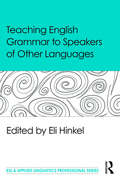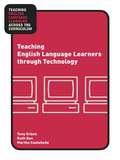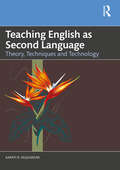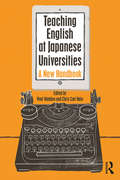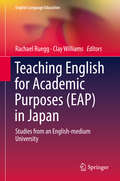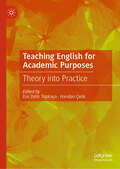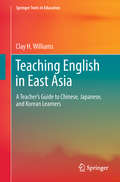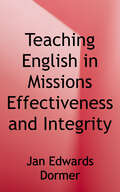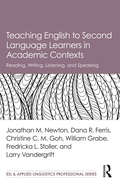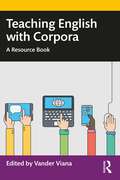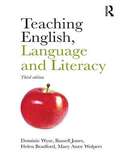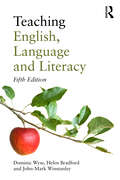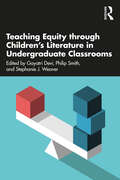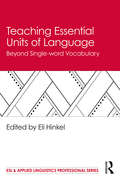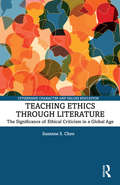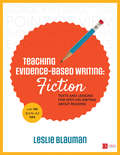- Table View
- List View
Teaching English Grammar to Speakers of Other Languages (ESL & Applied Linguistics Professional Series)
by Eli HinkelThis practical and research-based introduction to current and effective English grammar instruction gives pre-service and in-service teachers and teacher educators a strong foundation for teaching second language grammar and helps them develop their professional knowledge and skills. Written in a highly readable style for an international audience, it provides a thorough and rounded overview of the principles, strategies, techniques, and applications currently dominant in teaching L2 grammar in a range of instructional settings around the world. Chapter authors are world-class authorities in grammar and grammar teaching and learning. All chapters are based on theoretical frameworks and/or research foundations with a strong emphasis on practical applications and implications for classroom teaching, and highlight teaching methods, key concepts, and terminology associated with grammar instruction. Illuminating the options and choices in grammar teaching from a contemporary perspective, Teaching English Grammar to Speakers of Other Languages is ideal as key text for students in undergraduate and graduate MA-TESOL programs and as a resource for practicing ESL/EFL teachers, teacher educators, and teaching faculty.
Teaching English Language Learners in Career and Technical Education Programs
by Victor M. Hernández-Gantes William BlankExploring the unique challenges of vocational education, this book provides simple and straightforward advice on how to teach English Language Learners in today's Career and Technical Education programs. The authors' teaching framework and case studies draw from common settings in which career and technical educators find themselves working with ELLs—in the classroom, in the laboratory or workshop, and in work-based learning settings. By integrating CTE and academic instruction, and embedding career development activities across the curriculum, readers will gain a better understanding of the challenges of teaching occupationally-oriented content to a diverse group of learners in multiples settings.
Teaching English Language Learners through Technology
by Tony Erben Ruth Ban Martha CastañedaIn Teaching English Language Learners through Technology, the authors explore the use of computers/technology as a pedagogical tool to aid in the appropriate instruction of ELLs across all content areas. The special focus of this book is on the informed use of various technologies and software programs that can specifically aid ELLs. Strategies are also provided for varying levels of access--whether teachers teach in a one computer classroom, have access to multiple computers, or have the ability to go into a computer lab at their school. A fully annotated list of web and print resources completes the volume, making this a valuable reference to help teachers harness the power of computer-assisted technologies in meeting the challenges of including all learners in effective instruction.
Teaching English as Second Language: Theory, Techniques and Technology
by Aarati R MujumdarThis multidisciplinary volume is a systematic, well-researched resource to help understand the methods and techniques of teaching English as a second language. It integrates theory with praxis, drawing on the Cognitivist–Social interactionist theory and Constructivist approaches adopted in an English classroom. It provides insights into recent trends in teaching, given the changed teaching–learning scenario in education, while simultaneously aiding in the development of the 4IR skills much needed in the 21st century.Written in an easy-to-understand language, the book expounds on various language skills and their application in real-world classrooms. These classroom-tested techniques can be used by teachers by modifying the context in which they are used. The tasks help develop critical-thinking and problem-solving abilities in learners. The techniques and practices elucidated in the book are designed to be accessible to a global readership.This book will be useful to students, pre-service teachers, and researchers, who are new to the teaching of English Language. It will also be an essential companion to practicing in-service teachers and Teacher Trainers to further sharpen their concepts and skills.
Teaching English as a Second Language with Shakespeare (Elements in Shakespeare and Pedagogy)
by Fabio CiambellaTeaching pragmatics, that is, language in use, is one of the most difficult and consequently neglected tasks in many English as a Second Language classrooms. This Element aims to address a gap in the scholarly debate about Shakespeare and pedagogy, combining pragmatic considerations about how to approach Shakespeare's language today in ESL classes, and practical applications in the shape of ready-made lesson plans for both university and secondary school students. Its originality consists in both its structure and the methodology adopted. Three main sections cover different aspects of pragmatics: performative speech acts, discourse markers, and (im)politeness strategies. Each section is introduced by an overview of the topic and state of the art, then details are provided about how to approach Shakespeare's plays through a given pragmatic method. Finally, an example of an interactive, ready-made lesson plan is provided.
Teaching English as a Second Language: Theory and Praxis
by Aarati MujumdarA systematic and well-researched textbook with a multidisciplinary approach to understand the methods and techniques of teaching English as a second language. This book provides an easy-to-understand and easy-to-apply discussion on language structure, pronunciation, intonation, grammar, and vocabulary through numerous tasks and exercises. The section on "instructional practices" deals with various language skills and their applications in real-world classrooms. With actual classroom-tested techniques, Teaching English as a Second Language: Theory and Praxis would be an ideal companion for BEd students who are in the process of becoming teachers. It would also help practicing teachers who can modify and adapt these techniques and tasks to aid students develop language skills required to face the challenges of the twenty-first century. Key Features • Provides a comprehensive introduction to second language teaching with reference to the recent trends and developments in the area • Enables teachers to adopt a problem-solving approach to teaching English • Uses communicative language teaching (CLT) and task-based teaching methodology, helping learners to develop communication of meaning along with accuracy of form • Dedicated sections on classroom evaluation techniques and use of audiovisual aids and other resources for language teaching
Teaching English as an International Language: Implementing, Reviewing, and Re-Envisioning World Englishes in Language Education (Routledge Studies in World Englishes)
by Roby MarlinaHow do teachers inspire students to learn to appreciate different Englishes? Has anyone tried to teach world Englishes? If so, what do they do and how do they feel about it? Most importantly, do students see the benefits in learning about world Englishes? This book responds to these questions by 1) offering a clear and solid foundation for the development of English as an International Language (EIL)-oriented curricula in an English Language program and a teacher education program, 2) critically reviewing the current pedagogical principles and practices of teaching EIL, and 3) offering an alternative way of conceptualising and teaching EIL. Using a three-year undergraduate program of EIL in an Australian university as a research site, this book provides a detailed account of actual classroom practices that raise students’ awareness of world Englishes and engage them in learning how to communicate interculturally. This book is the first of its kind that explores the teaching of EIL in a country where English is a predominant and national language.
Teaching English at Japanese Universities: A New Handbook
by Paul Wadden Chris Carl HaleWritten by leading English-language educators in Japan, this Handbook provides an in-depth guide for the new generation of teachers at Japanese universities. In clear, accessible prose, it offers practical and detailed advice on effective classroom pedagogy, student motivation, learning styles, classroom culture, national language policy, career opportunities, departmental politics, administrative mindset, and institutional identity. Its four sections—The setting, The courses, The classroom, and The workplace—examine issues faced by university language teachers as well as challenges confronted by the increasing number of scholars teaching English as a Medium of Instruction (EMI) and Content and Language Integrated Learning (CLIL) courses. Firmly grounded in contemporary teaching method and theory, the Handbook’s 23 chapters also acknowledge the influence of diverse movements such as World Englishes, global issues, gender, and positive psychology. Its three appendices contain information on organizations, books, journals, and websites particularly useful for Japanese university educators; explanation of types and rankings of schools; ways to learn more about individual institutions for job-hunting; and detailed information on the structure (and Japanese titles) of faculty and non-teaching staff at the typical university. This Handbook is an invaluable resource for anyone teaching, or aspiring to teach, at a Japanese university.
Teaching English for Academic Purposes: Studies From An English-medium University (English Language Education #14)
by Clay Williams Rachael RueggThis book focuses on appropriate English for Academic Purposes instructional concepts and methods in the Japanese context. It investigates a variety of pedagogical techniques, addressing the fundamental academic English skills – listening, speaking, reading and writing – as well as assessment and materials development. All the research included was conducted in Japanese university settings, thus shedding new light on the effective implementation of EAP teaching and learning activities with Japanese learners of English. This book is of interest to anyone working in an EAP context at the secondary or tertiary level, especially those which include Japanese learners.
Teaching English for Academic Purposes: Theory into Practice
by Ece Zehir Topkaya Handan ÇelikThis book offers a helpful resource for English for Academic Purposes (EAP) practitioners, combining theoretical content with in-depth insights rooted in practice. EAP has a key role in preparing students for academic challenges in English-medium universities globally. With the increasing need for proficiency in academic English, there is a demand for a comprehensive resource that caters to instructors who are actively involved in or considering a career in the teaching of EAP. This book addresses this need through five clear thematic sections: the development of EAP practice and pedagogy, creating effective EAP courses, exploring linguistic issues, language skills, and EAP instruction, issues in assessment of learning and practice in EAP, and current perspectives in EAP. The volume features contributions from experts with extensive EAP teaching experience, research backgrounds, and scholarly publications. By drawing on their theoretical understanding and practical insights, the book will equip ELT professionals with essential knowledge, strategies, and practical approaches to tailor their instruction to the unique needs of EAP learners. It will also be of interest to teacher educators, students, and academics researching language teaching in English for Academic Purposes, English for Specific Purposes and English-Medium Instruction contexts.
Teaching English in East Asia
by Clay H. WilliamsThis book investigates the current EFL market in East Asia, focusing on K-12, university, and cram school English education in Japan, China, and Korea. It explores prevailing educational practices by both Asian learners and teachers of English, contrasting them with Western practices, and illuminating why Western pedagogical methods have often encountered tremendous resistance from teachers, administrators, parents, and students in the East Asian classroom context. After establishing this cultural contrast of pedagogical norms, the book presents a series of practical means for adapting Western teaching practices and philosophies to better suit the learning styles of East Asian students and the cultural context and practical realities of the East Asian classroom, offering both Western teachers working in East Asia and native East Asian teachers realistic plans for turning theory into successful practice. These plans are divided by subsections, focusing on the linguistic subskills being taught: listening/speaking, reading, and writing. Each section includes two contrasting lesson plans to demonstrate how the educational theories and practices promoted by the author can often be implemented by making relatively simple changes to existing practices that incorporate a fuller understanding of how to actively assist students in developing new learning styles and behaviors.
Teaching English in Missions: Effectiveness and Integrity
by Jan Edwards DormerEnglish Teaching is common in missions today. However, there has been relatively little discussion on what constitutes effectiveness in English ministries. <p><p>This book aims to foster such discussion. It first addresses issues of concern in English ministries and then suggests criteria for effectiveness, considerations in teacher preparation, and models for the teaching of English in missions.
Teaching English in Secondary Schools
by John GordonThis book is an indispensable guide for anyone training to become a secondary English teacher. It provides an overview of the main topics taught in schools, informed by good teaching practice drawn from the classroom and supported by research and theory, and engages with the requirements of the 2014 National Curriculum for England. Each chapter is based around a ‘lesson feedback’ case study informed by real classroom observations combined with research findings to explore and analyse what underpins high quality English teaching. Coverage includes: · Encouraging a love of reading in your classroom · How to teach effective writing for pleasure and for information · Developing students’ grammar, vocabulary and spoken English · Inspiring teaching using drama, poetry and Shakespeare · Intelligent use of media and new literacies in teaching This is essential reading on all secondary English initial teacher education courses, including school-based (SCITT, School Direct, Teach First), university-based (PGCE) and employment-based routes into teaching.
Teaching English in Secondary Schools
by John GordonThis book is an indispensable guide for anyone training to become a secondary English teacher. It provides an overview of the main topics taught in schools, informed by good teaching practice drawn from the classroom and supported by research and theory, and engages with the requirements of the 2014 National Curriculum for England. Each chapter is based around a ‘lesson feedback’ case study informed by real classroom observations combined with research findings to explore and analyse what underpins high quality English teaching. Coverage includes: · Encouraging a love of reading in your classroom · How to teach effective writing for pleasure and for information · Developing students’ grammar, vocabulary and spoken English · Inspiring teaching using drama, poetry and Shakespeare · Intelligent use of media and new literacies in teaching This is essential reading on all secondary English initial teacher education courses, including school-based (SCITT, School Direct, Teach First), university-based (PGCE) and employment-based routes into teaching.
Teaching English to Second Language Learners in Academic Contexts: Reading, Writing, Listening, and Speaking (ESL & Applied Linguistics Professional Series)
by William Grabe Dana R. Ferris Fredricka L. Stoller Larry Vandergrift Jonathan M. Newton Christine C.M. GohTeaching English to Second Language Learners in Academic Contexts: Reading, Writing, Listening, and Speaking provides the fundamental knowledge that ESL and EFL teachers need to teach the four language skills. This foundational text, written by internationally renowned experts in the field, explains why skills-based teaching is at the heart of effective instruction in English for academic purposes (EAP) contexts. Each of the four main sections of the book helps readers understand how each skill—reading, writing, listening, and speaking—works and explains what research has to say about successful skill performance. Pedagogically focused chapters apply this information to principles for EAP curriculum design and to instructional activities and tasks adaptable in a wide range of language-learning contexts. Options for assessment and the role of digital technologies are considered for each skill, and essential information on integrated-skill instruction is provided. Moving from theory to practice, this teacher-friendly text is an essential resource for courses in TESOL programs, for in-service teacher-training seminars, and for practicing EAP teachers who want to upgrade their teaching abilities and knowledge bases.
Teaching English to Speakers of Other Languages: An Introduction
by David NunanDavid Nunan's dynamic learner-centered teaching style has informed and inspired countless TESOL educators around the world. In this fresh, straightforward introduction to teaching English to speakers of other languages he presents teaching techniques and procedures along with the underlying theory and principles. Complex theories and research studies are explained in a clear and comprehensible, yet non-trivial, manner without trivializing them. Practical examples of how to develop teaching materials and tasks from sound principles provide rich illustrations of theoretical constructs. The content is presented through a lively variety of different textual genres including classroom vignettes showing language teaching in action, question and answer sessions, and opportunities to 'eavesdrop' on small group discussions among teachers and teachers in preparation. Readers get involved through engaging, interactive pedagogical features and opportunities for reflection and personal application. Each chapter follows the same format so that readers know what to expect as they work through the text. Key terms are defined in a Glossary at the end of the book. David Nunan's own reflections and commentaries throughout enrich the direct, up-close style of the text.
Teaching English to the World: History, Curriculum, and Practice
by George BraineTeaching English to the World: History, Curriculum, and Practice is a unique collection of English language teaching (ELT) histories, curricula, and personal narratives from non-native speaker (NNS) English teachers around the world. No other book brings such a range of international ELT professionals together to describe and narrate what they know best.The book includes chapters from Brazil, China, Germany, Hong Kong, Hungary, India, Indonesia, Israel, Japan, Lebanon, Poland, Saudi Arabia, Singapore, Sri Lanka, and Turkey. All chapters follow a consistent pattern, describing first the history of English language teaching in a particular country, then the current ELT curriculum, followed by the biography or the autobiography of an English teacher of that country. This consistency in the structuring of chapters will enable readers to assimilate the information easily while also comparing and contrasting the context of ELT in each country.The chapter authors--all born in or residents of the countries they represent and speakers of the local language or languages as well as English--provide insider perspectives on the challenges faced by local English language teachers. There is clear evidence that the majority of English teachers worldwide are nonnative speakers (NNS), and there is no doubt that many among them have been taught by indigenous teachers who themselves are nonnative speakers. This book brings the professional knowledge and experience of these teachers and the countries they represent to a mainstream Western audience including faculty, professionals, and graduate students in the field of ESL; to the international TESOL community; and to ELT teachers around the world.
Teaching English with Corpora: A Resource Book
by Vander VianaTeaching English with Corpora is an accessible and practical introduction to the ways in which online and offline corpora can be used in English language teaching (ELT). Featuring 70 chapters written by an international range of researchers and practitioners, this book: • provides readers with clear, tested examples of corpus-based/driven lesson plans; • contains activities relevant to English for general purposes and English for specific purposes; • caters for the needs of English language teachers working with learners at different proficiency levels; • features flexible teaching suggestions that can be explored as part of a lesson or as a full lesson. This book is an essential purchase for pre- and in-service English language teachers as well as those studying corpus linguistics in undergraduate/Master’s courses in applied linguistics, ELT and Teaching English to Speakers of Other Languages (TESOL).
Teaching English, Language and Literacy
by Dominic Wyse Russell Jones Helen Bradford Mary Anne Wolpert'This book is comprehensive, up-to-date, critical and authoritative. It is also, above all, well written. It will undoubtedly become standard reading for the next generation of teachers in training and practising teachers will also learn a great deal from dipping into its contents.' - David Wray, Professor of Literacy Education, University of Warwick '[A] well organised and comprehensive guide to the teaching of English and the teaching of language' Margaret Mallett - Emeritus Fellow of The English Association Are you looking for one book that covers every aspect of the teaching of English at primary level? Now fully updated, this third edition of Teaching English, Language and Literacy includes brand new chapters on children's literature and reading comprehension. Rooted in research evidence and multidisciplinary theory, this book is an essential introduction for anyone learning to teach English from the early years to primary school level. The authors draw on their research, scholarship and practice to offer advice on: developing reading, including choosing texts, and phonics teaching improving writing, including grammar and punctuation language and speaking and listening planning and assessing working effectively with multilingual pupils understanding historical developments in the subject the latest thinking in educational policy and practice the use of multimedia maintaining good home-school links gender and the teaching of English language and literacy All the chapters include clear examples of practice, coverage of key issues, analysis of research, and reflections on national policy to encourage the best possible response to the demands of national curricula. Each chapter also has a glossary to explain terms and gives suggestions for further reading. This book is for all who want to improve teaching English, language and literacy. Designed to help inform the practice of students on teacher training courses, but also of great use to those teachers wanting to keep pace with the latest developments in their specialist subject, this book covers the theory and practice of teaching English, language and literacy.
Teaching English, Language and Literacy
by Dominic Wyse Helen Bradford John-Mark WinstanleyAre you looking for one book that gives a comprehensive account of primary/elementary and early years English, language and literacy teaching? Based on robust research evidence and practical examples of effective teaching, this essential textbook critically evaluates curriculum policies and provides guidance for teachers on implementation of evidence-based teaching in classrooms. This fully revised fifth edition has a brand new chapter on Reading for Pleasure, and has substantially rewritten chapters to reflect recent developments in research, evaluations of new policy directions, and new practical examples of teaching and learning. The authors draw on their research, scholarship and practice to offer advice on: • inclusion and equality, including working effectively with multilingual pupils • the importance of talk and interaction • developing reading, including motivating children to read and phonics teaching • improving writing, including grammar and punctuation • planning and assessing • the latest educational policy and practice This authoritative book is an essential introduction for anyone who teaches English, language and literacy from the early years to primary school level, and seeks to improve their professional practice. Designed to help inform trainee teachers and tutors, but also of great use to those teachers wanting to keep pace with the latest developments in their specialist subject, this is an indispensable guide to the theory and practice of teaching English, language and literacy.
Teaching English, Language and Literacy (Routledge International Handbooks Of Education Ser.)
by Dominic Wyse Russell Jones Helen Bradford Mary Anne WolpertAre you looking for one book that gives a comprehensive account of primary and early years English, language and literacy teaching? This fully revised fourth edition of Teaching English, Language and Literacy includes up-to-date research and updated discussion of effective teaching. Throughout the book there is guidance on England’s new National Curriculum and its impact. Rooted in research evidence and multidisciplinary theory, this book is an essential introduction for anyone learning to teach English from the early years to primary school level. The authors draw on their research, scholarship and practice to offer advice on: inclusion and equality, including working effectively with multilingual pupils speaking and listening developing reading, including choosing texts, and phonics teaching improving writing, including grammar and punctuation planning and assessing the latest thinking in educational policy and practice the use of multimedia maintaining good home--school links All the chapters include examples of good practice, coverage of key issues, analysis of research and reflections on national policy to encourage the best possible response to the exciting challenges of teaching. Each chapter also has a glossary to explain terms and gives suggestions for further reading. This authoritative book is for all those who want to improve the teaching of English, language and literacy in schools. Designed to help inform trainee teachers and tutors, but also of great use to those teachers wanting to keep pace with the latest developments in their specialist subject, this is an indispensable guide to the theory and practice of teaching English, language and literacy.
Teaching Equity through Children’s Literature in Undergraduate Classrooms
by Philip Smith Gayatri Devi Stephanie J. WeaverChildren's literature has been taught in undergraduate classrooms since the mid-1960s and has grown to become a staple of English literature, library science, and education programs. Children's literature classes are typically among the most popular course offerings at any institution. It is easy to understand why; children's literature classes promise students the opportunity to revisit familiar works with fresh eyes. With the growth of the children’s publishing industry and the celebration of recent scholarly interventions in the field, the popularity of the discipline is unlikely to abate. A central question of current children’s literature scholarship and practice is how to effectively address contemporary questions of social justice. This collection offers a series of interventions for the practice of teaching equity through children's literature in undergraduate classrooms. It is intended for individuals who teach, or who are interested in teaching, children’s literature to undergraduates. It includes contributions from practitioners from a range of institutional affiliations, disciplinary backgrounds, nationalities, and career stages. Furthermore, this volume includes contributions from scholars who belong to groups which are often underrepresented within academia, due to race, nationality, ethnicity, gender identity, disability, or other protected characteristics.
Teaching Essential Units of Language: Beyond Single-word Vocabulary (ESL & Applied Linguistics Professional Series)
by Eli HinkelThis textbook provides a practical and research-based foundation for teaching second language (L2) multiword units (also commonly called collocations). Multiword units – such as strong tea, beautiful weather, or would you mind –cannot be readily understood or predicted by the meanings of their component parts, and prove particularly challenging for English language learners. With contributions from top scholars, this text presents a thorough and rounded overview of the principles and practices currently dominant in teaching L2 phrases in a variety of instructional settings around the world. Divided into two sections, Part I examines the pedagogical foundations of teaching the essential units of language. Part II covers a range of techniques and classroom activities for implementing instruction. Intended for students and teacher educators, this accessible volume integrates the key principles, strategies, and applications of current and effective English language instruction for both vocabulary and grammar.
Teaching Ethics through Literature: Igniting the Global Imagination (Citizenship, Character and Values Education)
by Suzanne S. ChooTeaching Ethics through Literature provides in-depth understanding of a new and exciting shift in the fields of English education, Literature, Language Arts, and Literacy through exploring their connections with ethics. The book pioneers an approach to integrating ethics in the teaching of literature. This has become increasingly relevant and necessary in our globally connected age. A key feature of the book is its integration of theory and practice. It begins with a historical survey of the emergence of the ethical turn in Literature education and grounds this on the ideas of influential Ethical Philosophers and Literature scholars. Most importantly, it provides insights into how teachers can engage students in ethical concerns and apply practices of Ethical Criticism using rich on-the-ground case studies of high school Literature teachers in Australia, Singapore and the United States.
Teaching Evidence-Based Writing: Texts and Lessons for Spot-On Writing About Reading (Corwin Literacy)
by Leslie A. BlaumanOne in a million. Yes, that’s how rare it is to have so many write-about-reading strategies so beautifully put to use. Each year Leslie Blauman guides her students to become highly skilled at supporting their thinking about texts, and in Evidence-Based Writing: Fiction, she shares her win-win process. Leslie combed the ELA standards and all her favorite books and built a lesson structure you can use in two ways: with an entire text or with just the excerpts she’s included in the book. Addressing Evidence, Character, Theme, Point of View, Visuals, Words and Structure, each section includes: Lessons you can use as teacher demonstrations or for guided practice, with Best the Test tips on how to authentically teach the skills that show up on exams with the texts you teach. Prompt Pages serve as handy references, giving students the key questions to ask themselves as they read any text and consider how an author’s meaning and structure combine. Excerpts-to-Write About Pages feature carefully selected passages from novels, short stories, and picture books you already know and love and questions that require students to discover a text’s literal and deeper meanings. Write-About-Reading Templates scaffold students to think about a text efficiently by focusing on its critical literary elements or text structure demands and help them rehearse for more extensive responses. Writing Tasks invite students to transform their notes into a more developed paragraph or essay with sufficiently challenging tasks geared for grades 6-8. And best of all, your students gain a confidence in responding to complex texts and ideas that will serve them well in school, on tests, and in any situation when they are asked: What are you basing that on? Show me how you know.
